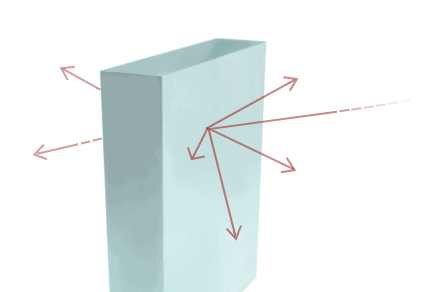Light has different properties that affect how we visualize objects. When waves encounter various barriers and mediums, like water, steel, or glass, they behave in different ways. Here, the team at Swift Glass shares the unique behaviors of light on glass.
Properties of Light
Light is a form of energy and part of a wider spectrum of electromagnetic radiation from the sun. Wavelengths tell us what type of light we’re dealing with. For example, microwaves and radio waves are on the long side of the spectrum, while UV rays and X-rays are much shorter.
When light hits an object, it may be absorbed, reflected, or refracted, depending on the type and shape of the material it hits. This is a key consideration when designing lenses, which are optical devices that use refraction to focus or disperse light. When creating lenses for microscopes, cameras, eyeglasses, and more, engineers have to consider the properties of the material and how light will interact with it.
Behaviors of Light
Light waves and particles interact with glass and other materials in different ways, depending on the type of light and the structure of the material:
- Transmission: The light passes directly through without being reflected, scattered, or absorbed. A transparent material, like a typical window, allows transmission of almost all light. An opaque material allows no transmission at all, and a translucent material, like a shower door, allows some transmission—however, that light gets scattered, which results in an unclear picture of what’s behind that translucent glass.
- Reflection: All types of waves, including light and sound, reflect off certain materials. When it comes to sound, certain animals, like bats, use that reflection (echoes) to find their way around. When it comes to light, smooth surfaces reflect it best: the perfect smoothness of a mirror gives us a clear reflected image, while the moving surface of the water gives us a blurry reflection. Reflection is also how we see color: a purple object, for example, is absorbing most of the wavelengths and reflecting the one we see as purple.
- Refraction: Light travels at different speeds through different mediums, and passing from one medium to another changes the direction of the light (refraction) and typically causes it to change speed. The bending of light through a convex lens can make objects appear larger.
- Diffraction: This is the bending and the spreading of the light waves—it’s what causes rainbows! You can also diffract light on purpose using a spectrometer to separate the wavelengths. This is useful in scientific applications to measure specific types of light.
- Absorption: When light photons hit the atoms and molecules that make up the highway, for example, those atoms vibrate and create heat. Dark materials (like a blackhighway) absorb more than light-colored materials (like the gray sidewalk)—which is why you may tend to prefer wearing a white shirt instead of a black shirt on a hot summer day.

- Scattering: This is when light bounces off the glass in multiple directions. There can be a little scattering or a lot, depending on which type of wave is scattering and what type of object it’s scattering off and through. This is why the sky is blue: nitrogen and oxygen scatter the short blue and violet waves, while the longer red and yellow waves pass right through. Violet waves are actually shorter and scatter more than the blue ones, but our eyes are more sensitive to blue, so that’s what we see when we look up on a clear day.
The way light behaves is fascinating, which is what makes the optical industry so exciting. Learn more about light and its properties and behaviors, or contact us for more information about custom glass fabrication. Swift Glass is a worldwide leader in high-quality glass manufacturing, and our experienced team works to ensure we meet your specifications and expectations as well as industry standards. We work on projects in a range of industries and applications. Request a quote today.



